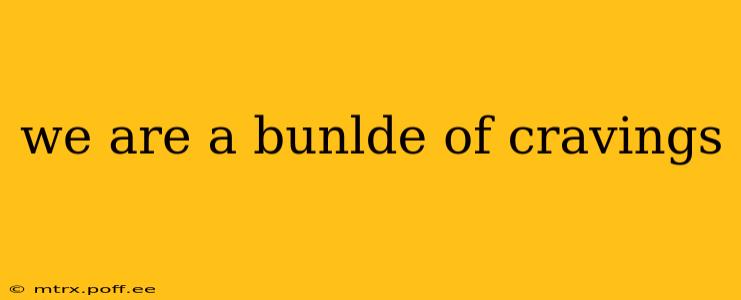We Are a Bundle of Cravings: Understanding and Managing Our Desires
We've all been there. That overwhelming urge for something specific, a powerful craving that seems to take over our senses. Whether it's a chocolate bar, a salty snack, or something more complex like the need for social connection or accomplishment, cravings are a fundamental part of the human experience. But what are they, exactly? And how can we navigate this bundle of desires in a healthy and fulfilling way?
This article delves into the science and psychology behind cravings, exploring why we experience them and offering practical strategies for managing them constructively.
What are cravings, exactly?
Cravings are intense desires for a specific substance or experience. They're more than just wanting something; they're characterized by an overwhelming urge that can be difficult to resist, often accompanied by strong emotional and physical sensations. These desires can range from simple food cravings to more complex psychological needs. The intensity and frequency of cravings can vary significantly depending on individual factors, such as genetics, environment, and underlying psychological conditions.
What causes cravings?
Several factors contribute to the experience of cravings:
-
Biological Factors: Our bodies require certain nutrients to function optimally. When we're deficient in specific vitamins, minerals, or other essential substances, we may experience cravings for foods rich in those nutrients. This is the body's way of signaling a need for replenishment. Hormonal fluctuations, particularly in women, can also trigger cravings.
-
Psychological Factors: Stress, boredom, anxiety, and depression are common triggers for cravings. We may turn to food or other substances as a coping mechanism to manage negative emotions or relieve stress. Learned associations, such as associating specific foods with positive memories or rewarding experiences, can also contribute to cravings.
-
Environmental Factors: Exposure to tempting foods or cues, such as advertisements or the smell of freshly baked goods, can trigger cravings. Social influences, like peer pressure or cultural norms surrounding food, also play a role.
How can I manage my cravings?
Managing cravings effectively requires a multifaceted approach:
-
Mindfulness: Pay attention to your body's signals. Before reaching for a tempting treat, pause and ask yourself if you're truly hungry or if it's an emotional craving. Mindful eating practices can help you become more aware of your eating patterns and identify triggers.
-
Healthy Coping Mechanisms: Develop alternative ways to manage stress, anxiety, and boredom. Engage in activities you enjoy, such as exercise, meditation, or spending time in nature. Building a strong support system can also provide emotional support during challenging times.
-
Balanced Diet: Eating a balanced diet that provides all the necessary nutrients can help reduce cravings. Focus on whole, unprocessed foods and limit processed foods, sugary drinks, and excessive amounts of unhealthy fats.
-
Gradual Changes: Making gradual changes to your diet and lifestyle is more sustainable than drastic measures. Start by making small, manageable changes, and gradually incorporate healthier habits into your routine. Avoid strict dieting, as this can often lead to increased cravings and binge eating.
-
Professional Support: If cravings are significantly impacting your life or you're struggling to manage them on your own, seeking professional support from a therapist or registered dietitian can be extremely beneficial.
Are cravings ever a sign of a medical condition?
While many cravings are simply a response to biological or psychological factors, sometimes they can indicate an underlying medical condition. For example, intense cravings for specific non-food items (pica) can be a symptom of nutrient deficiencies or certain mental health conditions. If you're experiencing unusual or persistent cravings, it's important to consult a healthcare professional to rule out any underlying medical issues.
How can I tell the difference between hunger and a craving?
Hunger is a physiological signal indicating your body needs energy. It’s often accompanied by a gradual increase in stomach rumbling and a general feeling of emptiness. Cravings, on the other hand, are often specific and intense desires for particular foods or substances, often driven by emotional or psychological factors rather than a genuine need for nutrients. They frequently appear suddenly and are not easily satisfied.
What are some healthy alternatives to satisfy cravings?
Instead of immediately indulging in unhealthy cravings, consider healthier alternatives. If you crave sweets, try a piece of fruit or a small amount of dark chocolate. If you crave salty snacks, reach for a handful of nuts or air-popped popcorn. Staying hydrated can often also alleviate cravings.
By understanding the complexities of cravings and implementing healthy strategies, you can better manage your desires and cultivate a healthier relationship with food and your overall well-being. Remember, seeking professional support when needed is a sign of strength, not weakness.
